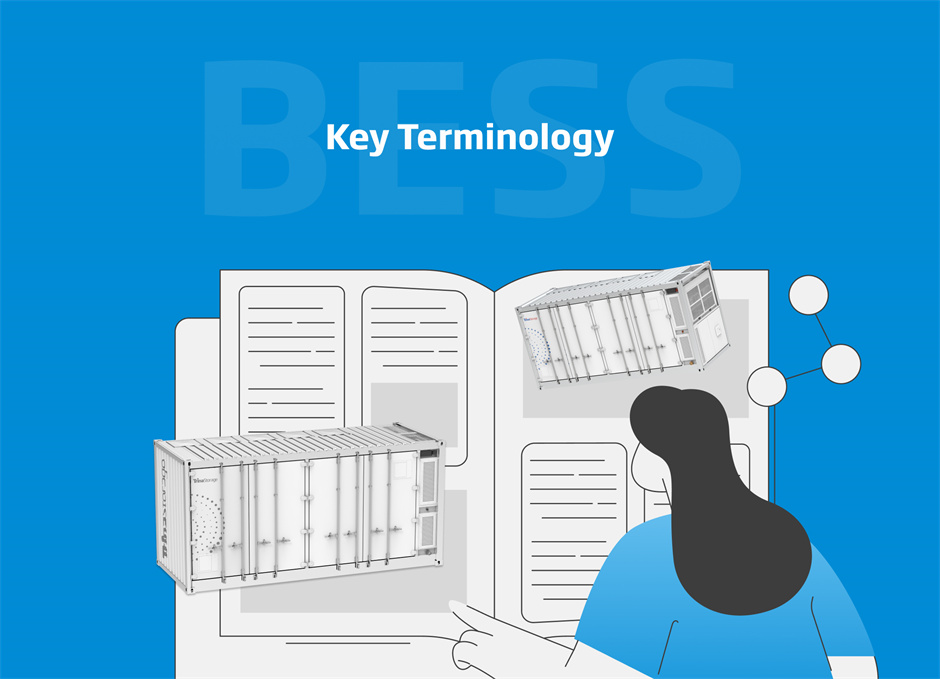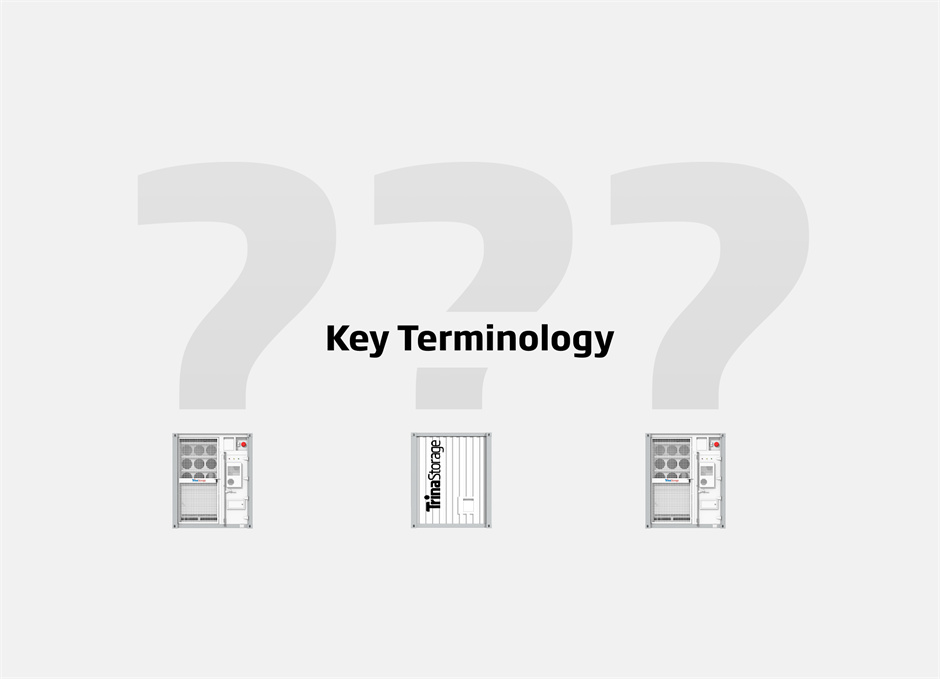A concise guide to the essential terms and acronyms used in the energy storage industry.
As the world races toward clean energy, understanding the language of energy storage is critical for making informed decisions and unlocking new opportunities.
At Trina Storage, we believe in making energy storage accessible and understandable to everyone. This guide deciphers the essential terms shaping our industry and innovations, complete with real-world examples and insights into why Trina's approach stands apart.

Energy Storage Systems Glossary
Key Terminology
Battery Energy Storage System (BESS)
A system using rechargeable batteries to store energy for later use, supporting grid stability, renewable integration, and backup power.
Example: When a utility faces peak demand in the evening, a BESS can discharge stored solar energy, reducing strain on the grid and avoiding costly infrastructure upgrades.
Power Conversion System (PCS)
Hardware that converts DC power from batteries to AC for the grid, or vice versa, enabling seamless integration with existing infrastructure. The PCS acts like a translator, ensuring stored energy can be used by homes and businesses connected to the AC grid.
Battery Cell
The fundamental unit of a battery, where energy is stored and released through electrochemical reactions. Trina's large-format prismatic LFP cells (e.g., 306Ah, 314Ah) are engineered for high efficiency and long life.
Integration
The process of combining hardware (cells, modules, containers, PCS) and software (EMS, BMS) into a unified, optimized storage solution. Trina's fully wrapped cell-to-AC approach ensures quality and reliability throughout the supply chain.
C-rate
The rate at which a battery charges or discharges relative to its capacity, indicating how quickly it can respond to energy demands.
Ah (Ampere-hour)
A measure of battery capacity; higher Ah values (like Trina's 306Ah/314Ah cells) translate to more energy storage and longer runtimes.
Depth of Discharge (DOD)
The percentage of a battery's capacity used before recharging.
Factory Acceptance Testing (FAT)
Rigorous validation of energy storage systems at manufacturing facilities to ensure compliance with design specifications.
Fire Suppression System (FSS)
Multi-layered safety mechanisms to detect and extinguish fires. Trina's Elementa series integrates gas detection, aerosol-based suppression, and explosion vent panels.

Optimisation and Efficiency for Energy Storage
Transitioning from the basics, let's explore the most important markers of efficiency and optimization driving value in modern energy storage.
Round-Trip Efficiency (RTE)
The ratio of energy output to energy input in a complete charge-discharge cycle. Lithium-ion batteries typically have excellent round-trip efficiency, within a range of 90 to 95 percent.
State of Charge (SoC)
The percentage of energy currently stored in a battery relative to its total capacity - similar to the fuel gauge in a car.
Cycle Life
The number of complete charge/discharge cycles a battery can perform before its capacity significantly degrades. Trina's latest battery cells deliver up to 12,000 cycles for long-term value.
High Consistency
Refers to the uniformity in performance and quality of battery cells, critical for safety and system efficiency.
Levelized Cost of Storage (LCOS)
A key metric expressing the total cost per unit of energy stored and delivered over a system's lifetime. Lower LCOS is achieved through high-efficiency cells, advanced cooling, and robust integration.
Example: LCOS is like calculating the cost per mile for a car over its lifetime, helping customers compare the true value of different storage solutions.

Innovation and Technology
Building on efficiency, innovation is what sets industry leaders apart.
Vertical Integration
Trina Storage's unique approach: we design and manufacture our own battery cells, modules, and systems, ensuring full quality control, transparency, and supply chain resilience. By controlling every step from cell to system, we can rapidly adapt to customer needs and market changes, reducing risk and improving reliability.
T-Shaped Strategy
Trina's
T-shaped strategy combines vertical integration (from cell to container) with broad horizontal capabilities (local engineering, sales, and service), ensuring both technical excellence and market expertise in every region. This approach means customers get both cutting-edge technology and local support, a rare combination in the industry.
Smart Cooling Systems
Advanced liquid or hybrid cooling technologies maintain optimal cell temperatures, boosting efficiency, safety, and lifespan. Trina's Elementa 2 Pro keeps temperature differences within ≤2.5°C in extreme environments for maximum performance.
In 2024, Trina Storage proudly achieved the world's first UL Verified Mark
certificate for thermal performance of its liquid-cooled energy storage containers, issued by UL Solutions.
Structural Integrity
Prismatic cell design with reinforced aluminum casing resists mechanical stress and extends lifespan.
Sustainability
As we innovate, sustainability remains at the core of our mission.
Environmental Product Declaration (EPD)
A third-party certification assessing a product's environmental impact across its lifecycle. Trina's Elementa 2 is the
world's first energy storage system to earn a 20-year full lifecycle EPD, reflecting our commitment to sustainable manufacturing and operation.
COP29 Energy Storage Pledge
Industry-wide commitments to accelerate the adoption of sustainable storage solutions, aligning with global climate goals.
Fire Mitigation and Suppression Systems
Multi-layered safety features, including heat and smoke sensors, gas detection (e.g., Honeywell Li-ion Tamer), and automatic fire suppression, built into Trina's storage systems to minimize risk.

Policy and Regulation
Finally, understanding the regulatory landscape is essential for project success.
Energy Storage Policies
National and regional regulations and incentives (such as tax credits, mandates, and safety codes) that drive market adoption and set performance, safety, and environmental standards.
UL 9540A
An international safety standard for testing fire and thermal runaway risks in battery energy storage systems. Compliance is essential for grid and building integration.
ISO 50001
A global standard for energy management systems, supporting efficiency and sustainability in industrial operations.
UL1973
Safety of battery systems for stationary applications.
IEC62619
Safety requirements for industrial lithium cells.
IEC63056
Safety of lithium batteries for electrical energy storage systems.
IEC62933-5-2
Safety of grid-integrated electrochemical storage systems.
IEC62477-1
Safety of power electronic converter systems.
RoHS
Restriction of hazardous substances in electrical equipment.
UN38.3
Safety testing for lithium battery transportation.
CE
EU health, safety, and environmental standards.
For more on policy and regulation, see our recent blog:
Navigating Policy & Regulation in Energy Storage.
Ready to Power the Future?
Trina Storage's vertically integrated, fully wrapped solutions deliver measurable value, reliability, and sustainability for grid-scale and commercial applications.
Our T-shaped strategy, global reach, and in-house technology ensure customers receive solutions that are not only innovative but also financeable and future-proof. Trina's bankability is recognized globally, with
Tier 1 status from BloombergNEF for eight consecutive quarters, and DNV certification for reliability and safety.
Download the
Advanced Battery Cell Technology for ESS whitepaper, contact our team of experts for tailored advice, or join us at our next event to see Trina Storage innovation in action.




